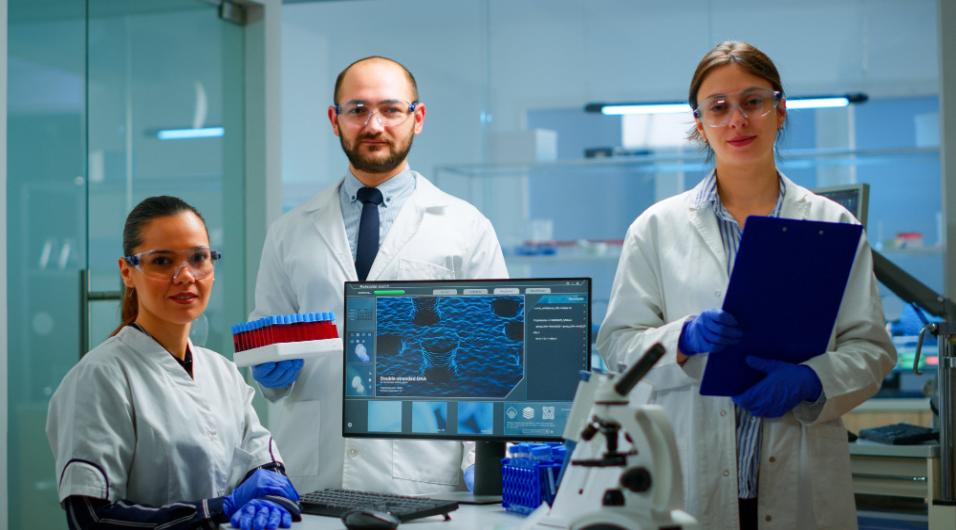
The Impact of English Bioengineers on Biomedical Innovations and Technological Advancements
Biomedical engineering has witnessed significant advancements and innovations driven by English bioengineers throughout history.
This research paper delves into the historical contributions of English bioengineers, exploring key innovations introduced by early pioneers and their profound impact on shaping the field of biomedical engineering.
Notable figures such as [mention notable English bioengineers] have played a pivotal role in laying the groundwork for major biomedical innovations, including groundbreaking devices that have revolutionized patient outcomes and medical practices. Despite facing technological challenges during the development process, English bioengineers have persevered, leading to the creation of cutting-edge technologies that have significantly contributed to the medical field.
Furthermore, this paper will examine the collaborative efforts and interdisciplinary work undertaken by English bioengineers, emphasizing the importance of partnerships with other scientific and medical professionals in driving successful biomedical innovations. Looking ahead, the future of biomedical engineering in England holds promising trends and opportunities, with English bioengineers at the forefront of global advancements in the field.
As we explore the impact of English bioengineers on biomedical innovations and technological advancements, it becomes clear that their contributions are shaping the future of healthcare and pushing the boundaries of what is possible in the realm of medical technology.
Historical Contributions of English Bioengineers
What were the key innovations introduced by early English bioengineers?
One of the most notable early contributions to bioengineering was the development of the stethoscope by René Laennec in 1816, which revolutionized diagnostic medicine by providing a non-invasive means to listen to the internal sounds of the body.
This invention not only marked a significant milestone in clinical diagnostics but also paved the way for the integration of physics and medicine, an interdisciplinary approach that has continued to drive innovations in bioengineering. Another key innovation was the advent of electrosurgery in 1920 by William T. Bovie, which allowed surgeons to cut tissue and control bleeding using electrical currents, thus significantly improving surgical outcomes and patient safety.
This breakthrough exemplifies how early bioengineers utilized their multidisciplinary training to develop technologies that addressed critical medical needs and improved clinical practices.
The cumulative impact of these innovations underscores the importance of fostering a robust and interdisciplinary bioengineering field, which continues to transform healthcare and medical research. To sustain and accelerate this progress, it is essential to ensure adequate funding and support for bioengineering research and development, thereby enabling the creation of novel solutions to emerging healthcare challenges.
How did these innovations influence the field of biomedical engineering?
The innovations in bioengineering and biomedical engineering have significantly influenced the field by integrating a wide array of technological advancements and interdisciplinary methodologies. These innovations have not only spurred advancements in medicine and biology but have also greatly contributed to the proliferation and evolution of bioengineering education globally, with a notable increase in the number of programs offered by universities.
Since the late 1950s, bioengineering education has been continuously evolving, leading to the development of new curricula that are particularly increasing in developing and transitional countries.
This growth is reflective of the field's dynamic nature and its ability to adapt and incorporate emerging frontiers in healthcare practices, such as functional medical imaging, regenerative medicine, and nanobiomedicine.
Moreover, the integration of accrued knowledge, expertise, and values from both engineering and biomedical sciences has enhanced the educational framework, preparing a new generation of bioengineers equipped to tackle complex biomedical challenges.
The dissemination of these innovations across generations ensures that the field remains at the forefront of technological and scientific progress, ultimately improving healthcare outcomes and expanding the boundaries of medical research.
Therefore, the continuous development and adaptation in bioengineering education and practice are crucial for sustaining the momentum of innovation and addressing future biomedical engineering challenges.
Which notable English bioengineers were pioneers in the field?
The evolution of bioengineering and biomedical engineering education can be attributed to the groundbreaking contributions of notable bioengineers. Among these pioneers, John H. Geddes stands out for his significant achievements in the field. Geddes was a key figure who preserved the physics-physician relationship, which was crucial in the early development of biomedical engineering as an interdisciplinary field.
Another notable pioneer is Otto Schmitt, whose work on instrumentation amplifiers has laid the foundation for critical biomedical terminology and advancements. Schmitt’s innovations have been pivotal in shaping the instrumentation techniques that are essential in modern medical diagnostics.
Additionally, the contributions of biochemical engineers like Peter Dunnill, who was instrumental in advancing prokaryotic metabolic engineering, highlight the diversity and depth of expertise within the field. Dunnill’s work has had a profound impact on both the scientific community and the broader economy, showcasing the multifaceted influence of bioengineering.
These pioneers not only advanced their respective areas of expertise but also collectively contributed to the establishment of bioengineering as a well-structured and recognized discipline.
As the field continues to grow, it is essential to acknowledge and build upon the foundational work of these early bioengineers, ensuring ongoing innovation and interdisciplinary collaboration.
Major Biomedical Innovations by English Bioengineers
What are some groundbreaking biomedical devices developed by English bioengineers?
One of the most significant advancements by English bioengineers is the development of prosthetic limbs that respond to neural signals, allowing for more natural and intuitive use by amputees.
This innovation represents a substantial leap forward in prosthetic technology, integrating neuroscience with mechanical engineering to create a more seamless interaction between the user and the device. Additionally, the creation of bionic eyes that can restore vision exemplifies another groundbreaking achievement, offering hope to those who have lost their sight and significantly improving their quality of life.
In the realm of patient monitoring, English biomedical engineers have also made notable contributions by developing bedside technologies such as electrocardioscopes and electroencephalography devices. These tools are essential for the continuous monitoring of heart and brain activities, providing critical data that can inform treatment decisions and improve patient outcomes.
Furthermore, the classification of physiological monitors into categories like cardiac, hemodynamic, respiratory, neurological, and body temperature monitoring underscores the comprehensive approach taken by these engineers to address various aspects of health monitoring.
Biomedical engineers also play a crucial role in this field by conducting basic research on physiological parameters and developing advanced biosensors, which are key to accurately assessing and monitoring patient health.
These interconnected innovations not only highlight the versatility and impact of English bioengineers but also underscore the ongoing need for interdisciplinary collaboration to push the boundaries of medical technology.
How have these devices improved patient outcomes and medical practices?
The advent of Left Ventricular Assist Devices (LVADs) has marked a significant turning point in the management of heart failure, directly improving patient outcomes by assisting failing hearts in pumping blood more efficiently.
Since their inception in the late 1960s, approximately 12,000 LVADs have been implanted worldwide, underscoring their widespread adoption and the profound positive impact on patient health.
This widespread acceptance and the success of LVADs have not only improved individual patient outcomes but have also catalyzed the emergence of new medical practices specifically tailored to the treatment of heart failure.
The integration of LVADs into clinical practice exemplifies how advanced medical technologies can reshape treatment protocols and standard care procedures, leading to enhanced clinical outcomes. This technological evolution aligns with broader trends in medical innovation, where state-of-the-art technologies, including advanced imaging equipment and minimally invasive surgical tools, have collectively contributed to more precise and effective medical interventions.
These advancements highlight the interconnected nature of medical technology, where innovations in one area can lead to systemic improvements in patient care and medical practice, ultimately driving the field towards more efficient and patient-centered healthcare solutions.
As a result, the continuous development and integration of such technologies in clinical settings are crucial for sustaining and further enhancing the quality of patient care.
What were the technological challenges faced during the development of these innovations?
Despite the expansion of bioengineering and biomedical engineering education, the development of innovations in these fields faces several significant technological challenges. One of the primary obstacles is the radical novelty and rapid growth of emerging technologies, which create a landscape filled with uncertainty and ambiguity regarding their outcomes and applications.
This uncertainty complicates the integration of new technologies into existing systems and requires continuous adaptation and learning by both developers and end-users. Furthermore, the ethical and responsible use of these technologies is paramount, particularly in autonomous systems and AI-assisted discoveries, to build and maintain trust among stakeholders and society at large.
For instance, developers working with AI in nanomaterials must provide thorough assurances to ethics committees about the anticipated and accounted-for risks associated with autonomously synthesized chemicals.
Additionally, the need for co-creation with patients, healthcare professionals, and end-users can pose challenges, as it requires a synergistic blend of design methods and tools from Industry 4.0 to address the multifaceted technological issues effectively.
Therefore, addressing these challenges necessitates a comprehensive approach that includes ethical considerations, collaborative design, and continuous interaction with regulatory bodies to ensure that innovations are both effective and trusted.
Technological Advancements Driven by English Bioengineers
What specific technologies have been advanced by English bioengineers?
One of the core advancements by English bioengineers lies in the field of microbiome engineering, which has opened new avenues for agricultural and environmental applications. By leveraging progress in genome sequencing and synthetic biology, bioengineers have developed strategies to construct synthetic microbiomes that possess novel functionalities, such as enhancing soil fertility and providing plant protection without the need for chemical pesticides.
This technological leap is particularly significant considering the increasing efforts to decarbonize economies, as it aligns with the broader goal of sustainability.
Furthermore, microbiome engineering can present viable alternatives to the use of antibiotics in livestock management, thus addressing both health and environmental concerns.
The implications of these technologies extend beyond agriculture; they also have the potential to transform rural areas into hubs for bio-based feedstock production, fostering a decentralized and sustainable approach to resource management.
As these innovations continue to gain traction, it will be crucial to overcome technical barriers in product processing to fully realize the benefits of bio-based materials.
This necessitates a collaborative effort between private investors and public policy frameworks to support and accelerate the transition to these sustainable technologies.
Hence, the interconnections between microbiome engineering, sustainable agriculture, and policy support underscore the multifaceted impact of bioengineering advancements on society and the environment.
How have these technological advancements contributed to the medical field?
The integration of technological advancements has had a profound impact on the medical field, particularly in enhancing diagnostic capabilities and treatment options. One of the most significant contributions is the incorporation of artificial intelligence (AI) and machine learning into healthcare engineering, which has revolutionized diagnostics, personalized medicine, and treatment optimization.
These advancements enable more accurate and faster diagnosis, allowing for timely interventions and tailored treatment plans that improve patient outcomes. Furthermore, engineering innovations have also played a crucial role in improving healthcare accessibility and cost-effectiveness, addressing emerging challenges such as the need for remote medical consultations through telehealth solutions.
Notable engineering applications, including medical imaging technologies and biomedical devices, have further transformed medical practices, fostering a more efficient and effective healthcare ecosystem.
However, despite these advancements, the translation of scientific innovations into practical medical devices has lagged, partly due to regulatory and financial hurdles, which often result in a lack of diversity in available medical devices.
To overcome these barriers, initiatives like the establishment of the National Center for Translational Sciences (NCATS) by the NIH aim to foster collaborative partnerships between various stakeholders to accelerate the bench-to-bedside process, ensuring that scientific innovations reach patients more quickly. These efforts highlight the need for continued support and strategic interventions to bridge the gap between technological innovation and clinical implementation, ultimately enhancing the quality and accessibility of healthcare.
What future technologies are currently being explored by English bioengineers?
Building on the robust foundation of bioengineering education, English bioengineers are at the forefront of cutting-edge research into future technologies that hold the promise of transformative impacts on medicine and human enhancement. A notable area of exploration is the development of neuron-like electronic probes designed to mimic the function of neurons.
These innovative probes are not only poised to revolutionize our understanding of neural activity but also to open new avenues for medical applications, such as the creation of advanced visual cortical prosthesis systems that could restore sight to the visually impaired.
Moreover, these biomimetic sensory probes are being engineered to facilitate new sensory capabilities, potentially enhancing human experience and interaction with the environment.
However, this advancement is not without its risks. The integration of such probes introduces potential vulnerabilities, including the risk of malicious attacks via the internet and the possibility of mass monitoring by law enforcement.
These dual-use concerns underscore the need for rigorous ethical and security frameworks to accompany technological innovation, ensuring that the benefits of these advancements are harnessed responsibly and safely.
Collaboration and Interdisciplinary Work
How do English bioengineers collaborate with other scientific and medical professionals?
Interdisciplinary collaborations between English bioengineers and other scientific and medical professionals are essential to better approach current societal challenges.
These collaborations often involve merging expertise from various fields such as biology, engineering, and medicine, leading to innovative solutions that could not be achieved within the confines of a single discipline. For instance, bioengineers may work with medical professionals to develop advanced prosthetics that are both functional and biocompatible, combining engineering principles with medical knowledge to improve patient outcomes. Similarly, collaborations with biologists can lead to the development of new biomaterials that can be used in tissue engineering and regenerative medicine, offering hope for conditions that currently have limited treatment options. By integrating different perspectives and areas of expertise, these interdisciplinary efforts can address complex problems more effectively, leading to significant advancements in healthcare and technology.
Therefore, fostering such collaborations is not only beneficial but necessary for tackling the multifaceted challenges of today's world.
What role does interdisciplinary work play in the success of biomedical innovations?
Interdisciplinary research has been a cornerstone in the development and success of biomedical innovations. This is evident in the creation of patented technologies, where the merging of expertise from diverse fields leads to advanced and novel solutions.
For instance, the integration of knowledge from engineering, biology, and medicine has enabled the development of cutting-edge medical devices and treatments that would have been impossible through a single-disciplinary approach. The degree of interdisciplinarity, specifically the balance between variety and disparity, plays a crucial role in determining the success of these innovations.
This balanced approach ensures that a wide array of perspectives is considered, fostering creativity and comprehensive problem-solving. Furthermore, research papers that cite a diverse range of disciplines and maintain an even distribution across these fields are more likely to receive patent citations, underscoring the tangible impact of interdisciplinary work.
The technological impact of biomedical innovations, as measured by the number of citing patents, is significantly heightened when the research embodies a balanced and disparate interdisciplinary nature.
Thus, fostering interdisciplinary collaborations not only enhances innovation but also ensures broader applicability and adoption of new technologies. To support this, introducing interdisciplinary courses at both educational and professional levels is essential, as it equips future innovators with the necessary skills to navigate and integrate multiple disciplines effectively.
This proactive approach is vital for sustaining the momentum of innovation in the biomedical field and addressing complex healthcare challenges.
Can you provide examples of successful interdisciplinary projects involving English bioengineers?
One prominent example of successful interdisciplinary projects involving English bioengineers is the collaboration between the Advanced Technology Centre (ATC) and Cambridge University (CU). This venture focused on design projects that integrated various fields such as engineering, biology, and human factors, fostering an inclusive engineering education environment. The project aimed to bridge gaps between these disciplines to create innovative solutions for real-world problems, ultimately achieving its initial goals of connecting diverse areas of expertise within a structured framework.
Moreover, the interdisciplinary nature of such collaborations underscores the importance of shared aims and mutual understanding among team members, which has been identified as a critical factor in ensuring the success of interdisciplinary research.
This example highlights not only the potential of interdisciplinary projects to generate impactful outcomes but also the necessity of a well-coordinated and pluralistic approach to meet the complex demands of contemporary bioengineering challenges.
Therefore, fostering an environment that encourages such collaborations is essential for advancing the field and addressing the multifaceted issues that require a blend of knowledge from different domains.
The Future of Biomedical Engineering in England
What trends are emerging in the field of biomedical engineering in England?
In the evolving landscape of biomedical engineering in England, several significant trends have been identified, reflecting a confluence of academic and industrial priorities. Key among these trends are the concepts of "Cellular biomechanics," "Mechanics of biological tissue," "Tissue engineering," and "Drug delivery," all of which were rated highly in terms of importance with scores surpassing 3.5 in both Academia and Industry.
This indicates a robust interest in understanding and manipulating biological structures at the cellular level, which has profound implications for the development of advanced therapeutic strategies and medical devices. Conversely, the biotechnology domain appears to be less of a focal point currently, with relatively low ratings of 3.07 and 3.26 from Academia and Industry, respectively.
This discrepancy suggests that while foundational biological engineering remains critical, there is a shifting emphasis towards more applied and integrative approaches within the field. Additionally, three new topics have gained prominence in the recent survey round: "Product safety and liability issues," "Generic design processes," and "Properties of Digital Signal Processing; Analog to Digital Signal Conversion".
These emergent areas highlight the increasing complexity and interdisciplinary nature of biomedical engineering, underscoring the need for robust safety protocols, standardized design methodologies, and advanced digital techniques to support innovative medical solutions. Collectively, these trends underscore the dynamic and multifaceted nature of biomedical engineering in England, pointing towards a future where cutting-edge research and practical applications continually inform and enhance each other.
How are English bioengineers preparing for future challenges and opportunities?
Emerging economies are playing a pivotal role in driving frugal innovation within the biomedical engineering (BME) field, which is proving to be a significant influence on how English bioengineers prepare for future challenges and opportunities.
This global perspective is further supported by the proliferation of new higher education programs focused on biomedical or clinical engineering in regions such as Africa, the Middle East, and Central and Southeast Asia.
These educational advancements not only broaden the scope of BME but also enhance the intercultural and interdisciplinary collaboration necessary for sustainable healthcare systems.
Moreover, English bioengineers are increasingly harnessing the potential of cutting-edge technologies, including smartphone-based applications, bioprinting for organ replacement, custom-made 3D printing medical devices, Artificial Intelligence (AI), and virtual reality, to address these emerging challenges.
This multidisciplinary approach underscores the importance of integrating scientific-technological excellence with a deep understanding of regional socio-cultural needs, ultimately aiming to create more effective and contextually relevant medical solutions.
In conclusion, by embracing these innovations and educational developments, English bioengineers are well-equipped to navigate and shape the future landscape of biomedical engineering.
What role will English bioengineers play in global biomedical advancements?
The role of English bioengineers in the context of global biomedical advancements is multifaceted and increasingly indispensable. One significant contribution lies in addressing the specific needs of low- and middle-income countries by developing medical technologies tailored to these settings. Such efforts are critical in overcoming challenges like high operating costs, lack of personnel, and environmental limitations.
Furthermore, English bioengineers are at the forefront of promoting educational and capacity-building initiatives, which are paramount for sustainable advancements in these regions.
By prioritizing training and strategic planning for human resources, they play a pivotal role in reinforcing medical and technical education globally.
This approach not only facilitates the local development and maintenance of medical technologies but also enhances the overall healthcare infrastructure, enabling more effective and equitable healthcare solutions worldwide. Thus, the work of English bioengineers is essential in bridging the gap between high- and low-resource settings, fostering a more inclusive and innovative global biomedical landscape.
The impact of English bioengineers on biomedical innovations and technological advancements is profound and far-reaching, as evidenced by the various breakthroughs and contributions highlighted in the research paper. The multidisciplinary training and collaborative efforts of early bioengineers have led to the development of technologies that address critical medical needs, improve clinical practices, and transform healthcare and medical research.
These innovations have not only revolutionized diagnostic medicine and surgical outcomes but have also paved the way for the integration of physics and medicine, driving continuous advancements in bioengineering. The evolution of bioengineering education, particularly in developing and transitional countries, reflects the dynamic nature of the field and its ability to adapt to emerging frontiers in healthcare practices.
The role of English bioengineers in global biomedical advancements is indispensable, with notable contributions in medical imaging technologies, biomedical devices, and patient monitoring technologies.
By prioritizing training, strategic planning for human resources, and harnessing cutting-edge technologies such as AI and bioprinting, English bioengineers are shaping the future landscape of biomedical engineering.
The discussion also emphasizes the importance of interdisciplinary collaboration between bioengineers, medical professionals, and other scientific experts to address current societal challenges effectively.
Despite the advancements in bioengineering and biomedical engineering education, challenges such as regulatory and financial hurdles still hinder the translation of scientific innovations into practical medical devices. Therefore, ongoing innovation, interdisciplinary collaboration, and sustainable funding and support for bioengineering research and development are crucial to address future biomedical engineering challenges.
The integration of advanced medical technologies like LVADs into clinical practice showcases how bioengineers are reshaping treatment protocols and improving clinical outcomes. Moreover, the development of prosthetic limbs that respond to neural signals demonstrates the innovative solutions bioengineers are creating to enhance patient care and quality of life. In conclusion, the work of English bioengineers underscores the need for continuous development and adaptation in bioengineering education and practice to foster a more inclusive and innovative global biomedical landscape.
By building upon the foundational work of early bioengineers, acknowledging technological challenges, and promoting interdisciplinary research, bioengineers are at the forefront of advancing medical technologies and improving healthcare outcomes worldwide.
The discussion highlights the critical role of English bioengineers in bridging the gap between high- and low-resource settings, fostering sustainable advancements in healthcare, and contributing to the ongoing progress of biomedical engineering.







